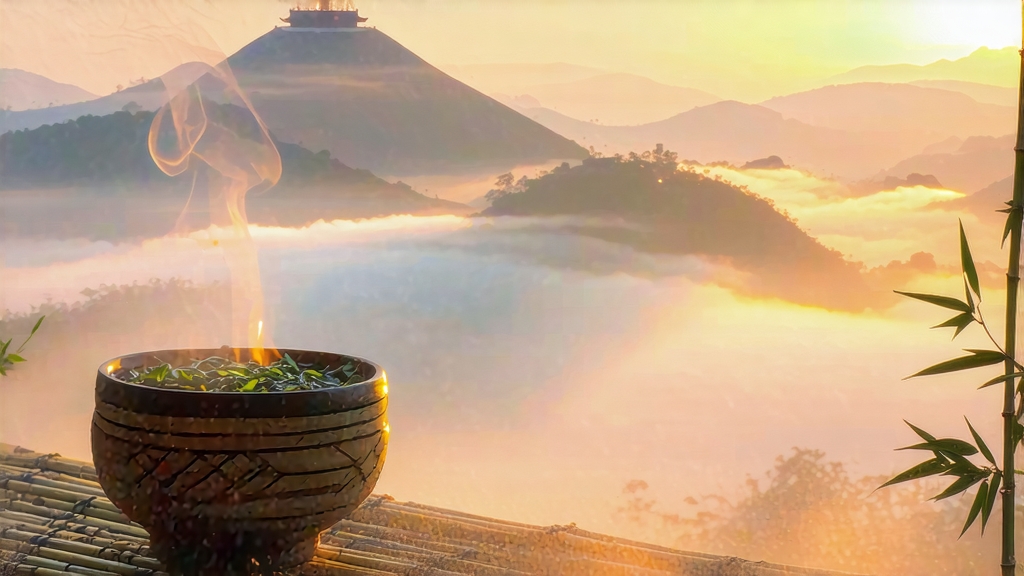
Tucked away in the mist-crowned peaks of Sichuan’s Meng Ding mountain range, Meng Ding Huang Ya—literally “Yellow Bud from Meng Ding”—is the quiet aristocrat of Chinese tea. While green tea commands the spotlight and pu-erh enjoys cult status, this yellow tea has spent centuries slipping in and out of history, beloved by emperors yet overlooked by merchants. Its story begins in the Tang dynasty (618-907), when the monk Wu Lizhen planted seven tea bushes on the summit of Meng Ding, an act recorded on a stone stele still standing today. By the Song era the buds were folded into imperial tribute lists, arriving in Beijing wrapped in silk and sealed with wax. Caravans carried it across the Tea-Horse Road, bartered for Tibetan horses, while poets compared its liquor to “liquid dawn.” Yet after the fall of the Qing, the technique faltered; by the 1950s only a handful of families remembered the exact rhythm of the “sealed yellowing” step that gives the tea its warm color and mellow sweetness. A state-led restoration in 1972 rescued both the cultivar and the craft, and today a protected geographic indication limits genuine Meng Ding Huang Ya to a 13-kilometer radius around the original 1,450-meter summit.
The tea belongs to the small, exclusive club of yellow teas, a category defined not by leaf shape but by a unique micro-fermentation. After picking, the buds undergo a gentle kill-green at lower temperature than green tea, preserving enzymes that will later “smother” the leaf in stacks of linen. This smothering, men huang in Chinese, lasts six to eight hours and is repeated three times; chlorophyll breaks down, polyphenols oxidize marginally, and a whisper of microbial activity edges the leaf from grassy toward honeyed. The result is a leaf that looks sage-green threaded with gold, a cup that glows like topaz, and a flavor that lands between the bright snap of green tea and the soft bass of lightly aged white.
Plucking is fanatically early: only the single unopened bud, or at most bud-and-half-open-leaf, gathered between Qingming and Grain Rain when the morning dew still weighs down the mossy paths. A skilled picker can harvest 600 grams of fresh buds per hour; 5 kg of these shrink to 1 kg of finished tea, explaining the regal price. The leaf is then withered for two hours on bamboo trays set in the shade of ginkgo trees, allowing surface moisture to evaporate while internal cells remain turgid. Kill-green follows in iron woks hand-hammered into a shallow parabola; the craftsman keeps his palm an inch above the base to judge when the temperature kisses 140 °C, then tosses the buds in a motion that mimics stir-frying shrimp. No machines, no thermometers—only the sizzle and the scent of toasted chestnut tell him when to stop.
Next comes the signature sealed yellowing. The still-warm leaves are piled 10 cm deep, wrapped first in steamed linen, then in a sheath of wild plantain leaves whose natural waxiness traps humidity. The bundle is slid into a cedar box and left in a cave-like room where mountain mist seeps through porous walls. Every two hours the pile is fluffed to release trapped CO₂, then re-wrapped; the leaf temperature hovers at 35 °C, hot enough to keep enzymes awake yet cool enough to prevent full oxidation. Over three cycles the leaf edges turn ochre, the aroma shifts from cut grass to dried apricot, and a faint golden down—tea “fluff”—rises to the surface. Finally the leaf is given a slow charcoal bake over embers of local birch, a step that locks in sweetness and adds a trace of smoked almond. The entire process stretches across three dawn-to-dusk days, after which the tea is left to “sleep” in unglazed clay jars for one month so moisture redistributes and flavors marry.
To brew Meng Ding Huang Ya, think of it as a shy guest who reveals herself slowly. Use 3 grams—about a level tablespoon—for 150 ml of water. The ideal vessel is a tall, thin-walled porcelain gaiwan whose pale interior amplifies the color narrative. Water should be 80 °C; anything hotter scorches the downy hairs and coaxes out tannic edges. Rinse the leaf for five seconds, discarding the wash to awaken the buds. First infusion: 45 seconds, pouring in a high, thin stream to aerate the liquor. The cup offers a perfume of orchards—quince, lo